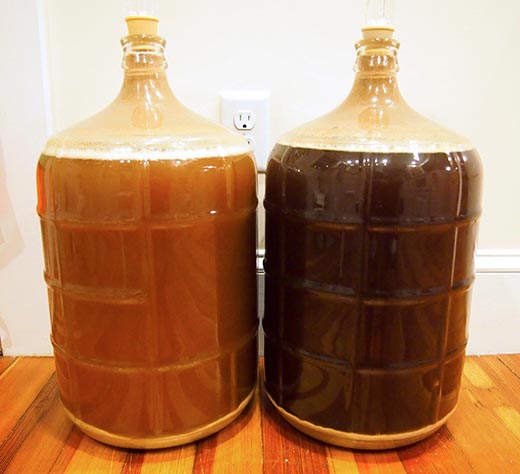 Hi there, I have to say, thank you for the amazing site. It’s been a wealth of knowledge… I will hopefully be moving cross country in the next few months. Currently I have two wines I am in the process of making… My questions are what would be the best way to transport a possibly bulk fermenting wine? If they are done fermenting am I safe to degas the wines, then plug the carboys and move or should I add something to either of them? As a side note, I do plan on making crates to protect the carboys…
Hi there, I have to say, thank you for the amazing site. It’s been a wealth of knowledge… I will hopefully be moving cross country in the next few months. Currently I have two wines I am in the process of making… My questions are what would be the best way to transport a possibly bulk fermenting wine? If they are done fermenting am I safe to degas the wines, then plug the carboys and move or should I add something to either of them? As a side note, I do plan on making crates to protect the carboys…
Isaac — WA
—–
Hello Isaac,
There are several concerns when moving homemade wine cross country: sunlight and temperature being my two biggest ones. Both of these promote oxidation in the wine. This is where a wine starts to take on a brownish or orange-like tinge, and the wine’s flavor starts to take on a bitter, raisin character.
You will want to keep the wines out of direct sunlight. You also want the wines’ temperature to stay consistent. The cooler the better. This will help to slow down the oxidative process, but i understand you can only do what you can do.
You can move the wine in carboys — degassed and sealed up tight — but if the wine warms up just a few degrees, it can pop the rubber stopper out of the carboy. Six gallons of wine can easily expand enough from any warmth to push out a stopper.
 You can wire down the stopper with some bailing wire. If the wine warms up a few degrees you should be fine, but if the wine warms up excessively, you could be building up considerable pressure in the carboy, which is never a good thing. Having a carboy fail is not unheard of in such situations.
You can wire down the stopper with some bailing wire. If the wine warms up a few degrees you should be fine, but if the wine warms up excessively, you could be building up considerable pressure in the carboy, which is never a good thing. Having a carboy fail is not unheard of in such situations.
Sediment is another concern when moving homemade wine cross country. The ideal situation is for all the sediment to be gone before moving. In other words, the wine has cleared up completely and is not depositing any new sediment. You have also removed the wine from all the sediment that has occurred.
Leaving the sediment in the carboys while traveling can promote a process call autolysis. This is when some of the live yeast cells start consuming some of the dead yeast cells. The result is a wine that starts to take on a nutty / to bitter / to metallic flavor. It is something that occurs to some insignificant degree in any wine, but when the sediment is contentiously being stirred up by the constant vibration of traveling, the amount of autolysis can become excessive.
Here’s What I Would Do If I Were Moving Homemade Wine Cross Country…
- Have the wine cleared and degassed. You would like to have the wine this far along in the winemaking process.
- Put the wine in carboys. The carboys should be topped-up. You do not want excessive head-space. There are several ways you can eliminate head-space in a carboy. Having excessive air in with the wine will help promote oxidation, as well.
- Add a dose of sulfite. This could be Campden tablets, potassium metabisulfite or sodium metabisulfite. Use 1/16 of a teaspoon per gallon or 1 tablet per gallon of wine. Sulfites will go a long way in help to reduce any effects of oxidation and help to keep the wine from from oxidation.
- Seal the carboys with an actual tapered cork stopper. Cork will allow some pressure to release if it built up. A rubber stopper will not give at all. A tapered cork stopper will breath a little.
- Wire down the tapered cork stopper with bailing wire. This can be done by going around the neck of the carboy with the wire, then running one strap of wire over the top of the cork stopper and securing the end.
Your idea of putting the carboys in crates is a good idea. You can never be too protective particularly when moving your homemade wine cross country.
Good luck to you. I hope this was the information you was looking for.
Happy Winemaking,
Ed Kraus
—————————————————————————————————————–
Ed Kraus is a 3rd generation home brewer/winemaker and has been an owner of E. C. Kraus since 1999. He has been helping individuals make better wine and beer for over 25 years.

My question is in regard to moving with your wine (cross country/state lines), as this article creates a some confusion that stems from a previous article. The article was about sending someone a bottle, across state lines is cause for arrest, and charges from both beginning and ending states. Where is moving your wine different from sending your wine. If the wine has completed and ready to bottle, it would just be a larger bottle you are sending. The person receiving would be the same name, only disguised by the moving truck, as opposed to the ups truck. Just asking…….
Kevin, everything you said is correct. It is really a matter of how likely will the wine be discovered, and once discovered will the detaining authority even know or care that it is a Federal issue. Being a quasi-governmental operation, going through the USPS posses higher risks.
A good rule is always put all cleaning products away leaving only your winemaking soap and sanitizer in your work area. I was sanitizing my carboy and indivertibly spray the inside of the carboy with a disinfecting cleaner with bleach! The carboy sat upside down for over an half an hour so there was only a coating of this cleaning agent present. There is no smell or taste of this product in the five gallons of pinot Grigio. I would like your impute on this, should I dump it or do you think the large quantity of liquid can tolerate my mistake. Thank you very much!
Robert, If you rinsed the inside of the carboy thoroughly, there should be no issue at all.